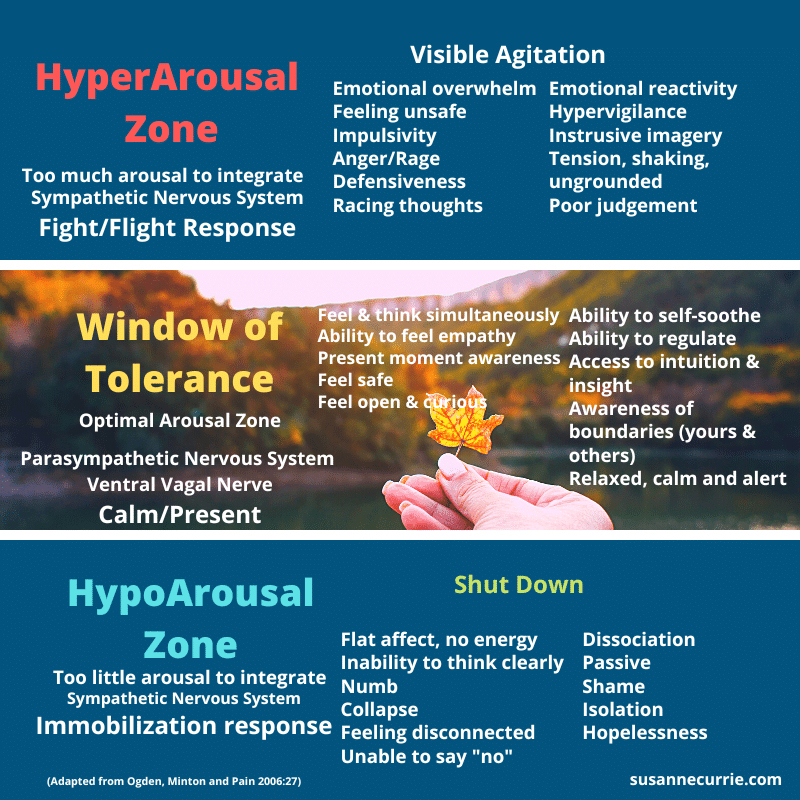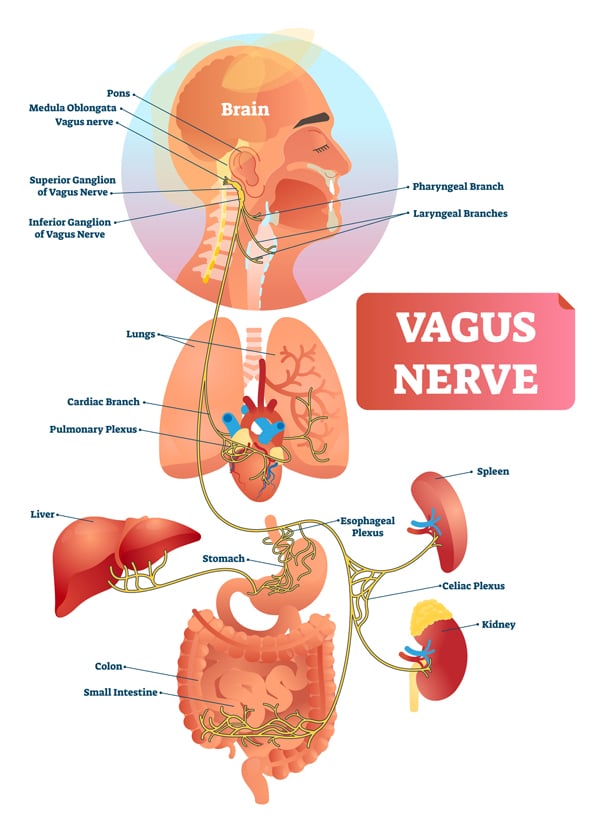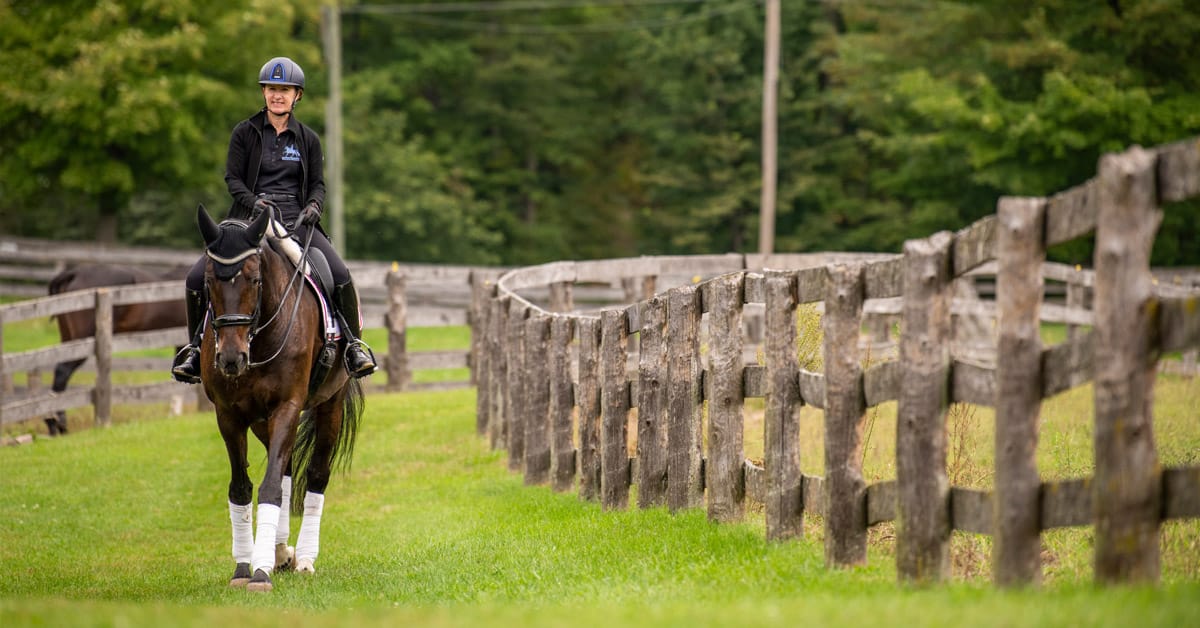“The horse feeds off our emotions. He responds by being worried or scared if we are – even if we aren’t worried or scared of the same thing. To communicate effectively, even on a trained and well-behaved horse, we need to be clear and deliberate so they can ‘hear’ us.”
~ Lisa Butowski, international Grand Prix rider
Our horses are innately tuned into us when we ride them, not only because their being is affected by ours, but also because they read and react to our emotional state at a deeply intuitive level.
One of the top traits of an Olympic athlete is the ability to cope with and control anxiety (i.e., the physical symptoms of anxiety, like nausea), lack of focus, and overall nervousness. Being able to manage our nervous system can be a vital component in becoming a successful equestrian. We want to readily be able to move back into our window of tolerance, where we are most effective, rather than being stuck in hyper or hypo arousal (see diagram).
 The good news is, improving our vagal tone (the activity of the vagus nerve) will help us become healthier humans and, as a bonus, help us ride our horses in an optimal state of being.
The good news is, improving our vagal tone (the activity of the vagus nerve) will help us become healthier humans and, as a bonus, help us ride our horses in an optimal state of being.
There are 12 cranial nerves in the body. They come in pairs and help to link the brain with other areas of the body, such as the head, neck, and torso. Some send sensory information to the brain, including details about smells, sights, tastes, and sounds. These nerves are known as sensory functions. Other cranial nerves control the movement of various muscles and the role of certain glands. These are known as motor functions.
While some cranial nerves have sensory or motor functions, others have both. The vagus nerve (also called cranial nerve X) is such a nerve. and is commonly known as the ‘wandering nerve’ because of the many different parts of the body it interacts with. The vagus nerve is the key to vagal tone, which can also be considered vagus nerve strength. The vagus nerve can improve athletic performance by increasing vagal tone, which in turn slows down heart rate, lowers blood pressure, reduces levels of cortisol, boosts immune function, prevents muscle catabolism/fatty acid breakdown during exercise, improves oxygen delivery to muscles, and suppresses gut motility.
In 2010, researchers discovered a positive feedback loop between high vagal tone, positive emotions, and good physical health. In other words, the more you increase your vagal tone, your physical and mental health will improve, and vice versa.
 An effective way to test for vagal tone is via an electrocardiogram, which measures heart rate variability (HRV), which is the amount of time between heartbeats. Although HRV is a heart rate function, it originates from your autonomic nervous system. Generally, the more variable the time between heartbeats, the better your vagal tone. For example, if your heart rate is 60 bpm, during that minute some beats may have 0.9 seconds between them, others 1.15 seconds, and so on. The greater this variability, the better the vagal tone, an indicator of your body’s readiness to perform. Readings will vary greatly from person to person, however, so there are really no standard baselines for what is considered ‘low’ or ‘high’ vagal tone.
An effective way to test for vagal tone is via an electrocardiogram, which measures heart rate variability (HRV), which is the amount of time between heartbeats. Although HRV is a heart rate function, it originates from your autonomic nervous system. Generally, the more variable the time between heartbeats, the better your vagal tone. For example, if your heart rate is 60 bpm, during that minute some beats may have 0.9 seconds between them, others 1.15 seconds, and so on. The greater this variability, the better the vagal tone, an indicator of your body’s readiness to perform. Readings will vary greatly from person to person, however, so there are really no standard baselines for what is considered ‘low’ or ‘high’ vagal tone.
Someone may treat low vagal tone with probiotics, specific vagal toning exercises, lifestyle choices, and other supplements. Still, it would be best to work with a functional medicine practitioner who has experience treating the vagus nerve in cases where chronic illness is present.
Some examples of vagal toning exercises are:
Humming: Humming has a strong effect on the vagus nerve. Try combining humming with yogic/meditative breathing. Take deep, slow breaths in through the nose, and hum “voo” as you slowly breathe out. Focus on the vibrations of your hum in your ribs, throat, mouth and head. Repeat until you feel relaxed. A good reason to sing your heart out in the shower or on your road trip to your next show!
Cold Water: I’m sure you have all seen a recent trend in ice water plunges; not only does this help your muscles, it increases your vagal tone. You can also do this by plunging your face for 30-60 seconds into icy water. This promotes what is known as the ‘diving reflex’. The vagus nerve signals your heart rate to slow to conserve oxygen. The Dive Reflex is a first-rate vagus nerve stimulation method. It’s capable of rapidly chilling down feelings of anxiety, panic, stress, body-wide inflammation, and elevating moods.
One-to-one breathing: Focus on breathing in for the same duration as you breathe out. This is a great mindfulness activity. The vagus nerve can be powerfully stimulated by calming and centring oneself via mindfulness or meditation.
Improving your vagal tone is vital in helping you create that optimal state of being when riding your horse at home or a show. As this article is a mere glimpse into vagal tone, read “Polyvagal Theory” by Dr. Stephen Porges to learn more.

